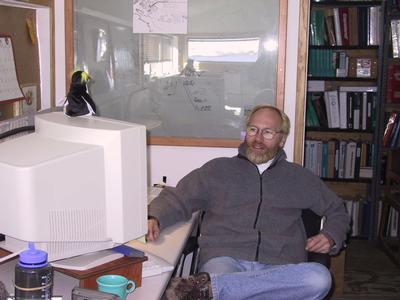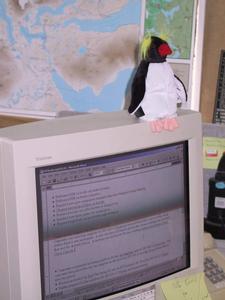10 February, 2002
WORKING IN ANTARCTICA
Many scientists come to one of the US Antarctic program
stations to gather samples and to work on experiments. People who are not
scientists work in Antarctica, also. There are many interesting jobs for
qualified people. If you want to check out available jobs, look at the
Raytheon Polar Services website, http://www.polar.org
Tom Cohenour is a person who supervises many workers here at Palmer Station.
Tom is the coordinator of the FEMC section. FEMC stands for "Facilities,
Engineering, Maintenance, and Construction." Tom is also the Palmer Station
correspondent for the Antarctic Sun, an online newspaper. You can find this
newspaper at http://www.polar.org/antsun Tom is from Grand Rapids,
Minnesota. This is his third summer at Palmer Station.
The FEMC section has a definite order of job priorities.
1. Life safety issues: frayed electrical cords or broken steps get the
first attention.
2. Science requests: maintenance or construction, either planned or
unplanned.
3. New construction
4. Maintenance: planned and unplanned, such as greasing bearings every
six months, or fixing broken items.
Tom explained that most of the construction work at Palmer Station takes
place in the winter, when there are fewer scientists here. During this
coming winter, there will be between 12-18 workers in the FEMC section.
They will be renovating the BioLab building. This summer, the FEMC section
is made up of six people: one electrician, one maintenance specialist, one
carpenter, two painters, and the coordinator of services. (Usually the
summer crew contains two carpenters and 1 painter).
Tom said that he is very careful in hiring people to come to Palmer Station.
He gave an example. "At McMurdo Station," he said, "there are 10-15
electricians. Here at Palmer Station we have only one electrician. So, if
something happens to that person, I have lost my entire department of
electricians!"
Tom said that FEMC has creative workers. "Using ingenuity is so critical",
he said. That's because people have to come up with ways to solve problems
when they are so far away from extra supplies and assistance. When Tom
hires, he first looks at the applicant's level of knowledge appropriate to
the job. Then he looks at job references. He calls at least three job
references, and more if possible. Tom looks carefully at the job
application itself. "A typed job application always gets my attention", he
said. "It's important that I am able to read the application. If it is
sloppily written, I can't read it easily".
Tom gave me a math problem based on a request from scientists (see the
journal for January 21, 2002 for a photo and explanation). Tom needed to
supply a scientist with some square pieces of Plexiglas. Each piece needed
to be 70 cm by 70 cm. The Plexiglas comes in sheets that are 4 feet by 8
feet. How many squares of Plexiglas can the FEMC group get out of each
sheet of Plexiglas?

Tom Cohenour, coordinator of FEMC (Facilities, Engineering, Maintenance, and Construction) at Palmer Station.

FEMC group members, (plus one), left to right: Gary Jirschele, maintenance; Tom Cohenour, FEMC coordinator; Tom Curran, electrician; Jeff Gustafson, carpenter; David Ensworth, power plant mechanic; Laura Hamilton, painter. Not in photo: Ryan Kloster, painter.

Tom Cohenour uses the computer to do a lot of his work. For example, he prepares weekly reports about his department and the work they have done.

This underwater photo (courtesy of Maggie Amsler) shows the experiment that required pieces of Plexiglas cut to the size 70cm by 70 cm.
Contact the TEA in the field at
.
If you cannot connect through your browser, copy the
TEA's e-mail address in the "To:" line of
your favorite e-mail package.
|
